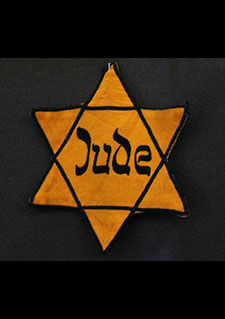Persecution of Jews
The populace protested very little against the Nazis’ Jewish policy and even some of the later conspirators of July 20, 1944 initially felt that the “Racial Laws” merited discussion at any rate.
The deportations of Jews from the German Reich began in October of 1941. Merely 50,000 of roughly 163,000 remained in early 1943. They owed their lives either to their “privileged” status of a “mixed marriage” or their work in the arms industry as slave laborers.
This changed in February of 1943: In Berlin, Jewish forced laborers, immediately identifiable by the “Jewish badge”, were collected from their workplaces in an “operation” (“factory operation”) in order to deport them. Without exception, they were men.
Numerous Jews who lived in “privileged mixed marriages” were among them. Something that remained unparalleled in the “Third Reich” happened: Their wives demonstrated before the transit camp on “Rosenstrasse”. Amazingly, they actually obtained the release of their detained Jewish husbands with their protest.
Victor Klemperer’s situation vividly illustrates that of the Jews still living in Germany. Klemperer had converted to Protestantism in 1912 but the Nazis considered him a Jew according to the Nuremberg Racial Laws of 1935. Since he was married to an “Aryan woman”, the pianist and painter Eva Schlemmer, he lived in a “privileged mixed marriage”, which protected him from deportation.
As his diary entries powerfully document, Klemperer was reminded of the fragility of his existence every day anew. On the evening of March 4, 1943, he noted: Exact numbers: 290 Jews were evacuated, there are altogether only a good 300 still here in Dresden, 130 of them wear the star. Hirschel was also in a grim mood. The Gestapo just notified him that they have bought his house, that he must vacate it within 10 day. He received rooms in the fellowship hall. Only a fraction of his furniture will fit in there, he is not allowed to rent storage space. He will try to store as much as possible in the fellowship hall cellars (Victor Klemperer: Die Tagebücher, p. 2691, cf. Klemperer-TB, p. 138, p. 817; http://www.digitale-bibliothek.de/band150.htm).
People such as Klemperer were subjected to ostracism and discrimination on a daily basis and feared for their lives. Mixed marriages were imperiled by plans that envisioned compulsory divorces in order to deport Jewish spouses immediately. Since the regime desired to avoid any public discussion of the “issue of mixed marriage” during the war however, compulsory divorce did not take effect, nor did the compulsory sterilization of “persons of mixed blood” pursued by Himmler.

